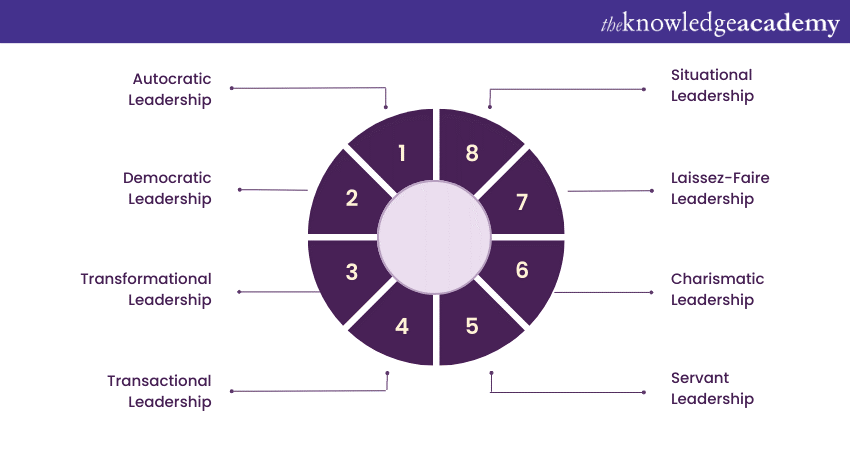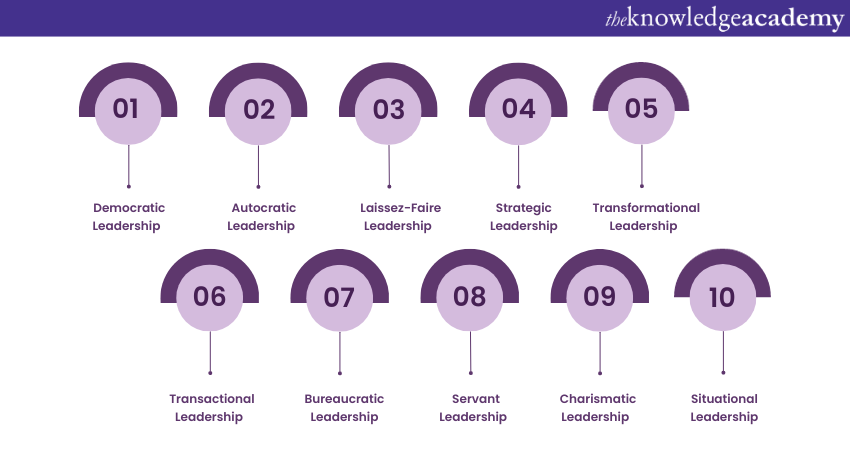We may not have the course you’re looking for. If you enquire or give us a call on +27 800 780004 and speak to our training experts, we may still be able to help with your training requirements.
Training Outcomes Within Your Budget!
We ensure quality, budget-alignment, and timely delivery by our expert instructors.

Leadership Styles play a crucial role in determining the success and effectiveness of individuals and organisations in the modern world. Understanding different Leadership Styles can help aspiring leaders enhance their capabilities and make informed decisions. In this blog, we will delve into various Types of Leadership Styles, their characteristics, and when to apply them to achieve desired outcomes.
Table of Contents
1) A brief introduction to Leadership
2) Types of Leadership Styles
3) How to develop your own Leadership Style?
4) Importance of knowing your Leadership Style
5) Conclusion
A Brief Introduction to Leadership
Leadership is termed as the ability to influence and guide individuals or a group toward achieving common goals. A leader's role goes beyond just giving orders; it involves inspiring, motivating, and supporting team members to unleash their full potential. There are various Leadership Styles which are nothing but distinct approaches that leaders adopt to lead and manage their teams.
Understanding the different types of leadership styles allows individuals to develop a versatile and adaptive approach to Leadership. Each style has its own strengths and weaknesses, and effective leaders know when and how to apply the right style to achieve their goals.
These styles are not a one-size-fits-all concept, and successful leaders continuously refine their approach to meet the evolving needs of their teams and organisation. By mastering the various styles, individuals can become impactful leaders. They can inspire, empower, and drive positive change within their teams and beyond.

Types of Leadership Styles
Leadership is a multifaceted concept encompassing various approaches to guide and influence individuals or groups towards achieving common goals. Let's delve into the details of some prominent Leadership Types:

Democratic Leadership
This is one of the most practised Types of Leadership Styles in the modern world. Democratic Leadership is characterised by its inclusive and participative nature. Leaders who adopt this style actively involve their team members in decision-making processes. They also seek their opinions, ideas, and feedback. By valuing their team's contributions, democratic leaders foster a sense of ownership among employees.
This approach often leads to enhanced creativity, collaboration, and mutual respect within the team. Employees feel empowered and motivated, resulting in higher job satisfaction and improved performance. However, it may require more time and consensus-building efforts, which might not be suitable for urgent or time-sensitive situations.
Autocratic Leadership
Autocratic Leadership is a traditional and authoritative approach where the leader holds absolute decision-making power. In this style, leaders seldom seek input from their team members, making decisions based on their own judgments and expertise.
The Authoritative Leadership Style emphasises building strong connections with each team member to offer personalised guidance and feedback, promoting individual success. Leaders employing this approach must demonstrate adaptability, especially as their team expands. While Authoritative Leadership involves hands-on engagement, leaders must exercise caution to avoid micromanagement tendencies. Overbearing involvement can lead to negative sentiments among team members. Striking a balance between active guidance and allowing autonomy is crucial for fostering a positive work environment and ensuring that the Authoritative Leadership Style remains effective without stifling the team's initiative.
Laissez-Faire Leadership
Laissez-Faire Leadership grants maximum autonomy to team members. Leaders adopting this style delegate decision-making authority to their team and refrain from intervening in day-to-day operations.
While it can effectively foster creativity and independent thinking, it might lead to a lack of direction or coordination within the team. Some employees may thrive in such an environment. On the other hand, others may struggle with the absence of clear guidance and support.
Therefore, the Laissez-Faire Style requires a highly skilled and self-motivated team who can handle responsibilities effectively without constant supervision. Here are the key characteristics of a Laissez- Faire leader:
a) Delegating decision-making authority to team members.
b) Holding individuals accountable for the decisions made.
c) Supplying essential tools and resources for tasks.
d) Encouraging and empowering team members to engage in problem-solving processes.
Strategic Leadership
Strategic leaders challenge entrenched assumptions in the workplace and encourage employees to voice alternative perspectives. In their managerial role, strategic leaders craft a tactical vision for the organisation and inspire their team to embrace it. A significant strength of strategic leaders lies in their capacity to assess various options and make decisions that contribute to the company's growth.
The primary characteristics of a strategic leader include:
a) Foreseeing potential challenges.
b) Possessing effective interpersonal skills.
c) Setting clear goals.
d) Demonstrating strong motivation.
Transformational Leadership
Transformational Leadership revolves around visionary leaders who inspire and motivate their followers to achieve extraordinary results. These leaders possess a strong sense of purpose and communicate a compelling vision for the future. They lead by example and exhibit passion and enthusiasm, encouraging their team members to strive for excellence. However, this style heavily relies on the leader's charisma and might be less effective if the leader lacks authenticity or struggles to articulate a compelling vision.
Transactional Leadership
Transactional Leadership is one of the commonly sighted Types of Leadership Styles. It is based on a simple exchange between the leader and their team members. It involves setting clear expectations, providing specific guidelines, and rewarding individuals for meeting predefined goals and objectives. Conversely, it also includes consequences for failing to meet expectations.
Transactional leaders focus on managing day-to-day tasks and performance. This ensures that the team adheres to established rules and procedures. While they can effectively maintain structure and discipline within the team, this style may not encourage innovation or long-term growth. Team members might become solely focused on fulfilling immediate targets rather than thinking strategically about the organisation's future.
Bureaucratic Leadership
Bureaucratic leaders adhere strictly to established rules and procedures. While they may consider employee input, any suggestions conflicting with company policies or historical practices may be dismissed. Key features of this Leadership Style include the following:
a) Centralised decision-making
b) Rigorous adherence to rules
c) A clear chain of command
d) Limited autonomy
Bureaucratic Leadership is most effective in larger, older, or traditionally successful companies, aiming to maintain existing processes. These businesses prefer sustaining their current strategies, avoiding experimentation that could potentially waste time and resources.
While it may pose challenges, the Bureaucratic approach offers several benefits. It minimises the risk of favouritism, providing job security and predictability. This structured Leadership Style can foster high levels of creativity in some employees.
While not as restrictive as Autocratic Leadership, Bureaucratic Leadership may limit individual freedom in roles, potentially stifling innovation. It may not be suitable for companies pursuing ambitious goals and rapid growth.
Servant Leadership
Servant Leadership is one of the altruistic Types of Leadership Styles that places the leader's focus on serving their team members and meeting their needs. Leaders practising this style prioritise the well-being and development of their employees. They actively listen to their team's concerns, offer support, and provide growth opportunities.
By putting their team first, servant leaders create a nurturing and positive work environment that fosters trust and loyalty. Employees feel appreciated, which leads to higher job satisfaction and improved team performance. However, this style may require a delicate balance between serving others and making critical business decisions to ensure overall success.
Charismatic Leadership
Charismatic Leadership hinges on the charm, magnetism, and persuasive abilities of the leader. Charismatic leaders possess a compelling presence that captivates and motivates their followers. They often have a clear vision and the ability to articulate it with passion. This helps instil a sense of purpose among their team members.
Charismatic leaders also create a strong emotional connection with their followers, inspiring loyalty and commitment to shared goals. However, a potential drawback of this style is that it heavily relies on the leader's personality and appeal. If the leader's charisma diminishes or if followers become overly dependent on the leader, it may impact the team's performance and cohesiveness.
Situational Leadership
Situational Leadership emphasises adaptability and flexibility in Leadership types. It depends on specific situations and the maturity level of team members. Leaders using this approach assess the readiness and capability of their team to perform certain tasks and adjust their style accordingly. For example, a team with less experience may require more guidance and direction, while a more experienced team may benefit from greater autonomy.
Situational leaders are skilled at assessing the needs of their teams and providing the appropriate level of support to help them succeed. This approach can be highly effective in diverse and dynamic environments.
Master the art of people management and team Leadership – sign up for our Successful People Management And Team Leadership Course today!
How to Develop Your own Leadership Style?
Developing a unique and effective Leadership Style is a journey of self-discovery, continuous learning, and intentional growth. Aspiring leaders can follow these essential tips to develop their own style:

Self-reflection and assessment
So, begin by reflecting on your values, strengths, weaknesses, and experiences. Further, seek feedback from colleagues, mentors, and team members to gain different perspectives on your approach.
Set clear goals
Define your Leadership goals and the impact you want to create as a leader. Setting clear objectives will help guide your development process. It will also help you shape your style towards achieving your vision.
Embrace authenticity
Authenticity is the cornerstone of effective Leadership. Be true to yourself and lead with integrity. Embrace your unique qualities and experiences. These abilities can set you apart as a leader and foster genuine connections with your team.
Learn from others
Study the styles of successful leaders you admire, both within your industry and beyond. Also, identify the aspects of their style that resonate with you and consider how you can integrate those elements into your own style.
Continuously learn and improve
Invest in your personal and professional development. Attend workshops, seminars or training programs to enhance your skills and knowledge. Seek mentorship from experienced leaders who can offer guidance and support on your journey.
Be adaptable
Effective leaders are adaptable and versatile. Understand that different situations and teams may require different approaches. Moreover, be open to adjusting your style based on the needs of your team and the challenges at hand.
Communicate clearly and empathetically
Communication is vital for Leadership success. Develop strong communication skills, both in conveying your vision and actively listening to your team members' perspectives. Moreover, show empathy and understanding to build trust and rapport.
Empower and delegate
Encourage the growth and development of your team members by empowering them with responsibilities and autonomy. Also, delegate tasks and trust your team to deliver results. Creating a culture of trust and empowerment fosters a sense of ownership among team members.
Lead by example
Actions speak louder than words. Lead by example and embody the values you wish to see in your team. Demonstrate a strong work ethic, resilience, and a willingness to learn from mistakes.
Seek feedback and adapt
Regularly seek feedback from your team to assess the effectiveness of your style. Be open to constructive criticism and use it as an opportunity for growth. Continuously refine and adapt your approach based on feedback and experiences.
Importance of knowing your Leadership Style
Understanding your Leadership Style is crucial for effective management and fostering a positive work environment. It enables you to tailor your approach, provide meaningful guidance, and make informed decisions. Awareness of your leadership style also sheds light on how employees perceive you, aiding in addressing potential areas for improvement. For instance, if feedback suggests an oppressive atmosphere, it may indicate an autocratic style requiring adjustment. Recognising your leadership style fosters self-reflection and empowers proactive enhancements. Importantly, it allows you to anticipate challenges associated with specific types, encouraging continuous development and creating a workplace where employees feel heard and valued.
Want to unlock your Leadership potential? Sign up for our Leadership Skills Course now!
Conclusion
There are diverse Types of Leadership Styles, and the effectiveness of each style depends on the context in which it is applied. Aspiring leaders should deeply understand these Leadership Styles to become well-rounded and adaptive leaders. By embracing the right style, individuals can inspire their teams, drive success, and positively impact their organisations' growth.
Take your Leadership skills to the next level by signing up for our Leadership Training today!
Frequently Asked Questions

The most effective Leadership Style for career advancement often depends on various factors, including the organisational culture, industry, and individual preferences. However, Leadership Styles that combine Transformational and Strategic Leadership elements are often considered beneficial for career growth.

Different Leadership Styles have distinct impacts:
a) Authoritative : Offers clear direction but limited team input.
b) Laissez-Faire : Promotes autonomy, fostering innovation.
c) Bureaucratic : Provides stability but limits creativity.
d) Transformational : Inspires and unifies teams.
e) Strategic : Emphasises long-term vision.

The Knowledge Academy takes global learning to new heights, offering over 30,000 online courses across 490+ locations in 220 countries. This expansive reach ensures accessibility and convenience for learners worldwide.
Alongside our diverse, Online Course Catalogue encompassing 17 major categories, we go the extra mile by providing a plethora of free educational like News updates, Blogs, videos, webinars, and interview questions. Tailoring learning experiences further, professionals can maximise value with customisable Course Bundles of TKA.

The Knowledge Academy’s Knowledge Pass, a prepaid voucher, adds another layer of flexibility, allowing course bookings over a 12-month period. Join us on a journey where education knows no bounds.

The Knowledge Academy offers various Leadership Courses, including Leadership Skills and Agile Leadership Trainings. These courses cater to different skill levels, providing comprehensive insights into Organisational Leadership.
Upcoming Business Skills Resources Batches & Dates
Date
 Successful People Management and Team Leadership
Successful People Management and Team Leadership
Fri 7th Jun 2024
Fri 2nd Aug 2024
Fri 4th Oct 2024
Fri 6th Dec 2024









 Top Rated Course
Top Rated Course


 If you wish to make any changes to your course, please
If you wish to make any changes to your course, please


